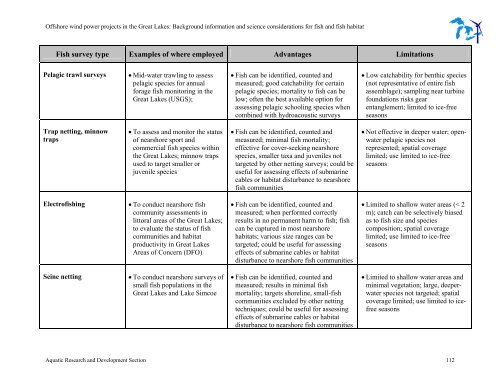Offshore Wind Power Projects in the Great Lakes - Ministry of ...
Offshore Wind Power Projects in the Great Lakes - Ministry of ...
Offshore Wind Power Projects in the Great Lakes - Ministry of ...
Create successful ePaper yourself
Turn your PDF publications into a flip-book with our unique Google optimized e-Paper software.
<strong>Offshore</strong> w<strong>in</strong>d power projects <strong>in</strong> <strong>the</strong> <strong>Great</strong> <strong>Lakes</strong>: Background <strong>in</strong>formation and science considerations for fish and fish habitat<br />
Fish survey type Examples <strong>of</strong> where employed Advantages Limitations<br />
Pelagic trawl surveys<br />
Trap nett<strong>in</strong>g, m<strong>in</strong>now<br />
traps<br />
Electr<strong>of</strong>ish<strong>in</strong>g<br />
Se<strong>in</strong>e nett<strong>in</strong>g<br />
• Mid-water trawl<strong>in</strong>g to assess<br />
pelagic species for annual<br />
forage fish monitor<strong>in</strong>g <strong>in</strong> <strong>the</strong><br />
<strong>Great</strong> <strong>Lakes</strong> (USGS);<br />
• To assess and monitor <strong>the</strong> status<br />
<strong>of</strong> nearshore sport and<br />
commercial fish species with<strong>in</strong><br />
<strong>the</strong> <strong>Great</strong> <strong>Lakes</strong>; m<strong>in</strong>now traps<br />
used to target smaller or<br />
juvenile species<br />
• To conduct nearshore fish<br />
community assessments <strong>in</strong><br />
littoral areas <strong>of</strong> <strong>the</strong> <strong>Great</strong> <strong>Lakes</strong>;<br />
to evaluate <strong>the</strong> status <strong>of</strong> fish<br />
communities and habitat<br />
productivity <strong>in</strong> <strong>Great</strong> <strong>Lakes</strong><br />
Areas <strong>of</strong> Concern (DFO)<br />
• To conduct nearshore surveys <strong>of</strong><br />
small fish populations <strong>in</strong> <strong>the</strong><br />
<strong>Great</strong> <strong>Lakes</strong> and Lake Simcoe<br />
• Fish can be identified, counted and<br />
measured; good catchability for certa<strong>in</strong><br />
pelagic species; mortality to fish can be<br />
low; <strong>of</strong>ten <strong>the</strong> best available option for<br />
assess<strong>in</strong>g pelagic school<strong>in</strong>g species when<br />
comb<strong>in</strong>ed with hydroacoustic surveys<br />
• Fish can be identified, counted and<br />
measured; m<strong>in</strong>imal fish mortality;<br />
effective for cover-seek<strong>in</strong>g nearshore<br />
species, smaller taxa and juveniles not<br />
targeted by o<strong>the</strong>r nett<strong>in</strong>g surveys; could be<br />
useful for assess<strong>in</strong>g effects <strong>of</strong> submar<strong>in</strong>e<br />
cables or habitat disturbance to nearshore<br />
fish communities<br />
• Fish can be identified, counted and<br />
measured; when performed correctly<br />
results <strong>in</strong> no permanent harm to fish; fish<br />
can be captured <strong>in</strong> most nearshore<br />
habitats; various size ranges can be<br />
targeted; could be useful for assess<strong>in</strong>g<br />
effects <strong>of</strong> submar<strong>in</strong>e cables or habitat<br />
disturbance to nearshore fish communities<br />
• Fish can be identified, counted and<br />
measured; results <strong>in</strong> m<strong>in</strong>imal fish<br />
mortality; targets shorel<strong>in</strong>e, small-fish<br />
communities excluded by o<strong>the</strong>r nett<strong>in</strong>g<br />
techniques; could be useful for assess<strong>in</strong>g<br />
effects <strong>of</strong> submar<strong>in</strong>e cables or habitat<br />
disturbance to nearshore fish communities<br />
• Low catchability for benthic species<br />
(not representative <strong>of</strong> entire fish<br />
assemblage); sampl<strong>in</strong>g near turb<strong>in</strong>e<br />
foundations risks gear<br />
entanglement; limited to ice-free<br />
seasons<br />
• Not effective <strong>in</strong> deeper water; openwater<br />
pelagic species not<br />
represented; spatial coverage<br />
limited; use limited to ice-free<br />
seasons<br />
• Limited to shallow water areas (< 2<br />
m); catch can be selectively biased<br />
as to fish size and species<br />
composition; spatial coverage<br />
limited; use limited to ice-free<br />
seasons<br />
• Limited to shallow water areas and<br />
m<strong>in</strong>imal vegetation; large, deeperwater<br />
species not targeted; spatial<br />
coverage limited; use limited to icefree<br />
seasons<br />
Aquatic Research and Development Section 112
















